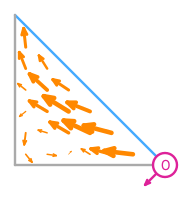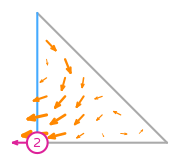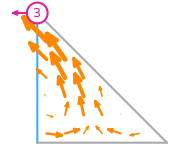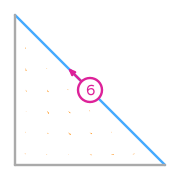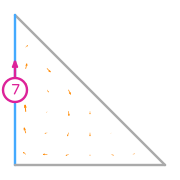an encyclopedia of finite element definitions
Degree 3 Mardal–Tai–Winther on a triangle
◀ Back to Mardal–Tai–Winther definition page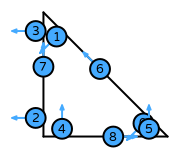
- \(R\) is the reference triangle. The following numbering of the subentities of the reference is used:
- \(\mathcal{V}\) is spanned by: \(\left(\begin{array}{c}\displaystyle 1\\\displaystyle 0\end{array}\right)\), \(\left(\begin{array}{c}\displaystyle x\\\displaystyle 0\end{array}\right)\), \(\left(\begin{array}{c}\displaystyle y\\\displaystyle 0\end{array}\right)\), \(\left(\begin{array}{c}\displaystyle 0\\\displaystyle 1\end{array}\right)\), \(\left(\begin{array}{c}\displaystyle 0\\\displaystyle x\end{array}\right)\), \(\left(\begin{array}{c}\displaystyle 0\\\displaystyle y\end{array}\right)\), \(\left(\begin{array}{c}\displaystyle x \left(x + 2 y\right)\\\displaystyle y \left(- 2 x - y\right)\end{array}\right)\), \(\left(\begin{array}{c}\displaystyle x \left(- x^{2} + 2 x + 3 y^{2}\right)\\\displaystyle y \left(3 x^{2} - 4 x - y^{2}\right)\end{array}\right)\), \(\left(\begin{array}{c}\displaystyle x \left(2 x y + x + 3 y^{2}\right)\\\displaystyle y \left(- 2 x y - 2 x - y^{2}\right)\end{array}\right)\)
- \(\mathcal{L}=\{l_0,...,l_{8}\}\)
- Functionals and basis functions:

\(\displaystyle l_{0}:\boldsymbol{v}\mapsto\displaystyle\int_{e_{0}}\boldsymbol{v}\cdot(1 - s_{0})\hat{\boldsymbol{n}}_{0}\)
where \(e_{0}\) is the 0th edge;
\(\hat{\boldsymbol{n}}_{0}\) is the normal to facet 0;
and \(s_{0},s_{1}\) is a parametrisation of \(e_{0}\).
\(\displaystyle \boldsymbol{\phi}_{0} = \left(\begin{array}{c}\displaystyle x \left(30 x^{2} + 144 x y - 57 x + 126 y^{2} - 138 y + 23\right)\\\displaystyle y \left(- 90 x^{2} - 144 x y + 114 x - 42 y^{2} + 69 y - 25\right)\end{array}\right)\)
This DOF is associated with edge 0 of the reference element.
where \(e_{0}\) is the 0th edge;
\(\hat{\boldsymbol{n}}_{0}\) is the normal to facet 0;
and \(s_{0},s_{1}\) is a parametrisation of \(e_{0}\).
\(\displaystyle \boldsymbol{\phi}_{0} = \left(\begin{array}{c}\displaystyle x \left(30 x^{2} + 144 x y - 57 x + 126 y^{2} - 138 y + 23\right)\\\displaystyle y \left(- 90 x^{2} - 144 x y + 114 x - 42 y^{2} + 69 y - 25\right)\end{array}\right)\)
This DOF is associated with edge 0 of the reference element.
\(\displaystyle l_{1}:\boldsymbol{v}\mapsto\displaystyle\int_{e_{0}}\boldsymbol{v}\cdot(s_{0})\hat{\boldsymbol{n}}_{0}\)
where \(e_{0}\) is the 0th edge;
\(\hat{\boldsymbol{n}}_{0}\) is the normal to facet 0;
and \(s_{0},s_{1}\) is a parametrisation of \(e_{0}\).
\(\displaystyle \boldsymbol{\phi}_{1} = \left(\begin{array}{c}\displaystyle x \left(- 42 x^{2} - 144 x y + 69 x - 90 y^{2} + 114 y - 25\right)\\\displaystyle y \left(126 x^{2} + 144 x y - 138 x + 30 y^{2} - 57 y + 23\right)\end{array}\right)\)
This DOF is associated with edge 0 of the reference element.
where \(e_{0}\) is the 0th edge;
\(\hat{\boldsymbol{n}}_{0}\) is the normal to facet 0;
and \(s_{0},s_{1}\) is a parametrisation of \(e_{0}\).
\(\displaystyle \boldsymbol{\phi}_{1} = \left(\begin{array}{c}\displaystyle x \left(- 42 x^{2} - 144 x y + 69 x - 90 y^{2} + 114 y - 25\right)\\\displaystyle y \left(126 x^{2} + 144 x y - 138 x + 30 y^{2} - 57 y + 23\right)\end{array}\right)\)
This DOF is associated with edge 0 of the reference element.
\(\displaystyle l_{2}:\boldsymbol{v}\mapsto\displaystyle\int_{e_{1}}\boldsymbol{v}\cdot(1 - s_{0})\hat{\boldsymbol{n}}_{1}\)
where \(e_{1}\) is the 1st edge;
\(\hat{\boldsymbol{n}}_{1}\) is the normal to facet 1;
and \(s_{0},s_{1}\) is a parametrisation of \(e_{1}\).
\(\displaystyle \boldsymbol{\phi}_{2} = \left(\begin{array}{c}\displaystyle - 24 x^{3} - 24 x^{2} y + 24 x^{2} + 36 x y^{2} - 24 x y + 4 x + 6 y - 4\\\displaystyle 2 y \left(36 x^{2} + 12 x y - 24 x - 6 y^{2} + 6 y - 1\right)\end{array}\right)\)
This DOF is associated with edge 1 of the reference element.
where \(e_{1}\) is the 1st edge;
\(\hat{\boldsymbol{n}}_{1}\) is the normal to facet 1;
and \(s_{0},s_{1}\) is a parametrisation of \(e_{1}\).
\(\displaystyle \boldsymbol{\phi}_{2} = \left(\begin{array}{c}\displaystyle - 24 x^{3} - 24 x^{2} y + 24 x^{2} + 36 x y^{2} - 24 x y + 4 x + 6 y - 4\\\displaystyle 2 y \left(36 x^{2} + 12 x y - 24 x - 6 y^{2} + 6 y - 1\right)\end{array}\right)\)
This DOF is associated with edge 1 of the reference element.
\(\displaystyle l_{3}:\boldsymbol{v}\mapsto\displaystyle\int_{e_{1}}\boldsymbol{v}\cdot(s_{0})\hat{\boldsymbol{n}}_{1}\)
where \(e_{1}\) is the 1st edge;
\(\hat{\boldsymbol{n}}_{1}\) is the normal to facet 1;
and \(s_{0},s_{1}\) is a parametrisation of \(e_{1}\).
\(\displaystyle \boldsymbol{\phi}_{3} = \left(\begin{array}{c}\displaystyle 48 x^{3} + 120 x^{2} y - 66 x^{2} + 36 x y^{2} - 60 x y + 16 x - 6 y + 2\\\displaystyle 2 y \left(- 72 x^{2} - 60 x y + 66 x - 6 y^{2} + 15 y - 7\right)\end{array}\right)\)
This DOF is associated with edge 1 of the reference element.
where \(e_{1}\) is the 1st edge;
\(\hat{\boldsymbol{n}}_{1}\) is the normal to facet 1;
and \(s_{0},s_{1}\) is a parametrisation of \(e_{1}\).
\(\displaystyle \boldsymbol{\phi}_{3} = \left(\begin{array}{c}\displaystyle 48 x^{3} + 120 x^{2} y - 66 x^{2} + 36 x y^{2} - 60 x y + 16 x - 6 y + 2\\\displaystyle 2 y \left(- 72 x^{2} - 60 x y + 66 x - 6 y^{2} + 15 y - 7\right)\end{array}\right)\)
This DOF is associated with edge 1 of the reference element.
\(\displaystyle l_{4}:\boldsymbol{v}\mapsto\displaystyle\int_{e_{2}}\boldsymbol{v}\cdot(1 - s_{0})\hat{\boldsymbol{n}}_{2}\)
where \(e_{2}\) is the 2nd edge;
\(\hat{\boldsymbol{n}}_{2}\) is the normal to facet 2;
and \(s_{0},s_{1}\) is a parametrisation of \(e_{2}\).
\(\displaystyle \boldsymbol{\phi}_{4} = \left(\begin{array}{c}\displaystyle 2 x \left(6 x^{2} - 12 x y - 6 x - 36 y^{2} + 24 y + 1\right)\\\displaystyle - 36 x^{2} y + 24 x y^{2} + 24 x y - 6 x + 24 y^{3} - 24 y^{2} - 4 y + 4\end{array}\right)\)
This DOF is associated with edge 2 of the reference element.
where \(e_{2}\) is the 2nd edge;
\(\hat{\boldsymbol{n}}_{2}\) is the normal to facet 2;
and \(s_{0},s_{1}\) is a parametrisation of \(e_{2}\).
\(\displaystyle \boldsymbol{\phi}_{4} = \left(\begin{array}{c}\displaystyle 2 x \left(6 x^{2} - 12 x y - 6 x - 36 y^{2} + 24 y + 1\right)\\\displaystyle - 36 x^{2} y + 24 x y^{2} + 24 x y - 6 x + 24 y^{3} - 24 y^{2} - 4 y + 4\end{array}\right)\)
This DOF is associated with edge 2 of the reference element.
\(\displaystyle l_{5}:\boldsymbol{v}\mapsto\displaystyle\int_{e_{2}}\boldsymbol{v}\cdot(s_{0})\hat{\boldsymbol{n}}_{2}\)
where \(e_{2}\) is the 2nd edge;
\(\hat{\boldsymbol{n}}_{2}\) is the normal to facet 2;
and \(s_{0},s_{1}\) is a parametrisation of \(e_{2}\).
\(\displaystyle \boldsymbol{\phi}_{5} = \left(\begin{array}{c}\displaystyle 2 x \left(6 x^{2} + 60 x y - 15 x + 72 y^{2} - 66 y + 7\right)\\\displaystyle - 36 x^{2} y - 120 x y^{2} + 60 x y + 6 x - 48 y^{3} + 66 y^{2} - 16 y - 2\end{array}\right)\)
This DOF is associated with edge 2 of the reference element.
where \(e_{2}\) is the 2nd edge;
\(\hat{\boldsymbol{n}}_{2}\) is the normal to facet 2;
and \(s_{0},s_{1}\) is a parametrisation of \(e_{2}\).
\(\displaystyle \boldsymbol{\phi}_{5} = \left(\begin{array}{c}\displaystyle 2 x \left(6 x^{2} + 60 x y - 15 x + 72 y^{2} - 66 y + 7\right)\\\displaystyle - 36 x^{2} y - 120 x y^{2} + 60 x y + 6 x - 48 y^{3} + 66 y^{2} - 16 y - 2\end{array}\right)\)
This DOF is associated with edge 2 of the reference element.
\(\displaystyle l_{6}:\boldsymbol{v}\mapsto\displaystyle\int_{e_{0}}\boldsymbol{v}\cdot(1)\hat{\boldsymbol{t}}_{0}\)
where \(e_{0}\) is the 0th edge;
and \(\hat{\boldsymbol{t}}_{0}\) is the tangent to edge 0.
\(\displaystyle \boldsymbol{\phi}_{6} = \left(\begin{array}{c}\displaystyle 3 x \left(- 2 x^{2} - 8 x y + 3 x - 6 y^{2} + 6 y - 1\right)\\\displaystyle 3 y \left(6 x^{2} + 8 x y - 6 x + 2 y^{2} - 3 y + 1\right)\end{array}\right)\)
This DOF is associated with edge 0 of the reference element.
where \(e_{0}\) is the 0th edge;
and \(\hat{\boldsymbol{t}}_{0}\) is the tangent to edge 0.
\(\displaystyle \boldsymbol{\phi}_{6} = \left(\begin{array}{c}\displaystyle 3 x \left(- 2 x^{2} - 8 x y + 3 x - 6 y^{2} + 6 y - 1\right)\\\displaystyle 3 y \left(6 x^{2} + 8 x y - 6 x + 2 y^{2} - 3 y + 1\right)\end{array}\right)\)
This DOF is associated with edge 0 of the reference element.
\(\displaystyle l_{7}:\boldsymbol{v}\mapsto\displaystyle\int_{e_{1}}\boldsymbol{v}\cdot(1)\hat{\boldsymbol{t}}_{1}\)
where \(e_{1}\) is the 1st edge;
and \(\hat{\boldsymbol{t}}_{1}\) is the tangent to edge 1.
\(\displaystyle \boldsymbol{\phi}_{7} = \left(\begin{array}{c}\displaystyle 6 x \left(- 2 x^{2} - 4 x y + 3 x + 2 y - 1\right)\\\displaystyle 6 y \left(6 x^{2} + 4 x y - 6 x - y + 1\right)\end{array}\right)\)
This DOF is associated with edge 1 of the reference element.
where \(e_{1}\) is the 1st edge;
and \(\hat{\boldsymbol{t}}_{1}\) is the tangent to edge 1.
\(\displaystyle \boldsymbol{\phi}_{7} = \left(\begin{array}{c}\displaystyle 6 x \left(- 2 x^{2} - 4 x y + 3 x + 2 y - 1\right)\\\displaystyle 6 y \left(6 x^{2} + 4 x y - 6 x - y + 1\right)\end{array}\right)\)
This DOF is associated with edge 1 of the reference element.
\(\displaystyle l_{8}:\boldsymbol{v}\mapsto\displaystyle\int_{e_{2}}\boldsymbol{v}\cdot(1)\hat{\boldsymbol{t}}_{2}\)
where \(e_{2}\) is the 2nd edge;
and \(\hat{\boldsymbol{t}}_{2}\) is the tangent to edge 2.
\(\displaystyle \boldsymbol{\phi}_{8} = \left(\begin{array}{c}\displaystyle 6 x \left(4 x y - x + 6 y^{2} - 6 y + 1\right)\\\displaystyle 6 y \left(- 4 x y + 2 x - 2 y^{2} + 3 y - 1\right)\end{array}\right)\)
This DOF is associated with edge 2 of the reference element.
where \(e_{2}\) is the 2nd edge;
and \(\hat{\boldsymbol{t}}_{2}\) is the tangent to edge 2.
\(\displaystyle \boldsymbol{\phi}_{8} = \left(\begin{array}{c}\displaystyle 6 x \left(4 x y - x + 6 y^{2} - 6 y + 1\right)\\\displaystyle 6 y \left(- 4 x y + 2 x - 2 y^{2} + 3 y - 1\right)\end{array}\right)\)
This DOF is associated with edge 2 of the reference element.
